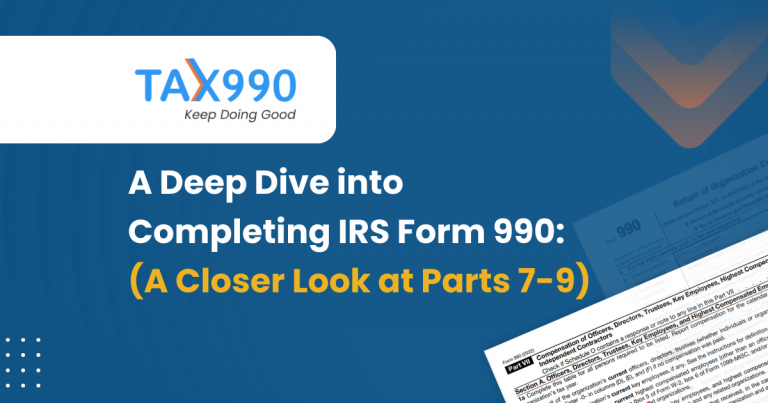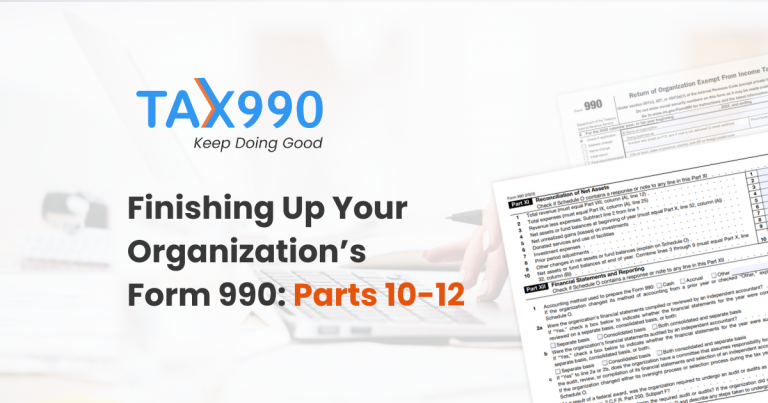Estimated reading time: 15 minute(s)

Many people think that nonprofit organizations don’t have strict IRS reporting requirements because they are tax-exempt. This is a major misconception. Those who operate or work closely with nonprofit organizations will tell you that they actually file very detailed tax returns with the IRS each year.
For certain nonprofits, their deadline to file tax-exempt 990 returns is right around the corner.
In this blog we will cover which types of organizations are required to file their 990 Series return by October 16th, how organizations determine their deadline, tips for meeting the upcoming deadline, and more.
Keep reading for your October 990 deadline checklist!
Which Nonprofit Organizations have a 990 deadline on October 16th?
Tax-exempt organizations, classified as 501(c)3 organizations by the IRS, are assigned an annual 990 deadline based on the fiscal year that they file.
Organizations that have a fiscal tax year beginning on June 1st and ending on the following May 31st, will have a deadline on October 16, 2023.
While the IRS 990 filing deadlines generally fall on the 15th of the month, this month the 15th falls over a weekend. When this happens, the next business day automatically becomes the deadline.
How Do Nonprofit Organizations Determine their 990 Deadline?
The IRS has a rule in place to help tax-exempt organizations determine when their annual tax returns are due.
The deadline for tax-exempt organizations to file their annual 990 return is the 15th day of the 5th month following the end of their tax year.
Organizations can generally find information about when their tax year begins and ends on their IRS determination letter. It can also be found in their by-laws and on the form (1023, 1034, etc.) that they filed to apply for tax-exempt status from the IRS.
Tax990 helps organizations take the guesswork out of determining their 990 deadline with a free tool. You can use our Form 990 Due Date Calculator here!
How Does a Nonprofit Organization Select and File the Correct 990 Return?
After ensuring that your organization is filing by the correct deadline, the next most important step in the filing process is determining which 990 to file, there is an entire 990 series of returns after all!
The key takeaway is that the gross receipts an organization generates and its structure will determine the return that it should file.
It is also important to note that small organizations can file the 990 long form rather than a Form 990-N or 990-EZ. This is often useful for providing granting organizations and donors with more detailed information about their finances. This often allows small organizations to secure grant opportunities and larger donations.
However, this doesn’t work both ways, an organization can NOT file a shorter 990 return than what the IRS requires.
Here is a brief overview of the 990 Series Returns, and the types of organizations that they pertain to:
| 990 Return | Which Organizations Should File it? | More information |
| 990-N | This 990 form is designed for the smallest organizations with $50,000 or less in gross receipts. | Click here for an overview of the Form 990-N, also referred to as the E-postcard. |
| 990-EZ | The 990-EZ is designed for organizations with gross receipts of up to $200,000, and total assets of less than $500,000. | Click here to learn about the short form. Form 990-EZ. |
| 990 | Form 990 is filed by organizations with gross receipts of $200,000 or more (or) assets of $500,000 or more. As mentioned above, smaller organizations can file this to provide their donors/granting organizations with additional financial information. | Click here for more information about the 990 Long Form. |
| 990-PF | All organizations that are structured as private foundations (regardless of gross receipts) must file Form 990-PF. | Click here for an overview of Form 990-PF for private foundations. |
| 990-T | Form 990-T is an additional filing requirement for any organization that has generated $1,000 or more in revenue during the tax year that is not directly related to their tax-exempt purpose. A simple example of this would be a community theater company that sells food and beverages at their shows/events. This revenue is helpful for the organization, but technically not directly related to their mission.
|
Learn more about the requirements for filing Form 990-T for UBI here. |
Depending on the size, scope, and purpose of your organization, you may also be required to attach certain 990 Schedules, you can learn more about these here!
Tips for Meeting Your Organization’s 990 Deadline -E-file with Tax990!
Now that the IRS requires all tax-exempt organizations to file their annual 990 returns electronically, finding an IRS-authorized e-file provider that meets all of your filing needs is crucial!
Whether this is your first 990 return, or you are an expert at filing on behalf of your organization, Tax 990 offers a streamlined solution to simplify your compliance with the IRS.
With time-saving features such as including your 990 Schedules for free, the option to copy data from the previous returns you’ve filed with us, and a built-in audit feature for accuracy, 990 filing has never been easier.
Be sure to take advantage of everything Tax990 has to offer when you file with us this year. For example, you can collaborate with your team members to file returns for your organization from a single, secure Tax990 account. You can also share returns with your board members and/or executives for Review and Approval before transmissions.
We help you through every stage of the filing process by allowing you to correct and retransmit any rejected 990 forms at no additional cost. Plus, we provide solutions for any amendments you may need to file.
Ready to get started and meet your deadline with ease!
Create your free Tax990 account today to begin filing!




